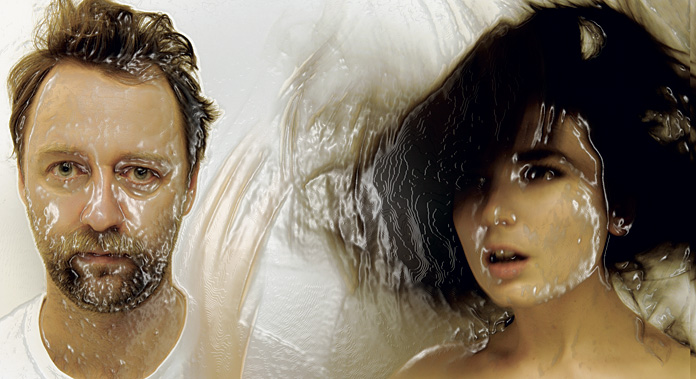
OOFJ
Worlds Collide
Oct 03, 2013
Issue #46 - June/July 2013 - Charli XCX
![]()
Over cocktails on the deck of their Los Angeles apartment, Danish musician Jenno Bjørnkjær and South African singer Katherine Mills Rymer giddily recount their courtship. The engaged couple met through mutual friends in New York when Rymer was a student at the prestigious Stella Adler Studio of Acting. Now they make dark, melancholy soundscapes as OOFJ, but Bjørnkjær’s initial motivations for sharing his work with Rymer weren’t professional.
“What he would do to woo me is to send me his tracks,” she recounts with an animated lilt. “My parents were there at the time, when he was on his woo fest. He would phone all the time. Three times a day. My mom was like, ‘Who’s that? The composer?’ ‘Yes mom, it’s the composer.’ She thought it was very glamorous.”
In love, the couple moved to Los Angeles so Rymer could pursue acting (which she’s still doing alongside music). She blushes when Bjørnkjær describes the transition, saying, “It was very easy for me to do that, I knew she was special.”
It wasn’t until an extended trip to South Africa, after the death of Rymer’s father, that Bjørnkjær hit on the idea of including her in his music. Although nervous about the idea of singing in public, she was eager to try out her theatrical education.
“I know how to breathe and use my diaphragm,” she says, comically emulating a Grand Dame of the theater while describing the voice training she received. “For six months we lie on our back and breathe, and they will not allow you near text. You are not even allowed to say a poem! It’s old school.”
With Rymer on board, the duo fleshed out the songs of their cinematic debut LP, Disco to Die. Featuring both strings from the Prague Symphony Orchestra and crackling electronics, Disco to Die presents an elegant and sinister soundtrack that wouldn’t sound out of place accompanying a noir film. Against the silhouetted musical backdrop, Rymer’s sweet soprano shape-shifts, sometimes sounding like an innocent little-girl-lost, other times evoking the deadliest of femme fatales.
The album’s contrast between classical and electronic instrumentation creates an unusual tension, but as Bjørnkjær describes it, the combining of elements was an important part of his development as a musician. Although having come to the United States to train and work as a saxophonist, he ultimately felt limited by the parameters of his craft.
“With jazz, I can practice all my life, but people would always rather buy a record with Stan Getz,” he notes. “Moving into electronic music was like taking a big black cloud away.”
Bjørnkjær is quick to note that the music didn’t really come to life until the addition of his paramour’s vocals.
“When I make music on my own, it’s very brainy,” he says. “In some way it’s very easy for me to do something that three people find amazing…. When she came along, suddenly people responded to it in a very different way. Not only the voice, but also it was so much more emotional, the whole thing. It was for your whole, as opposed to only for your brain.”
Current Issue

Issue #72
Apr 19, 2024 Issue #72 - The ‘90s Issue with The Cardigans and Thurston Moore
Most Recent
- Under the Radar Announces The ’90s Issue with The Cardigans and Thurston Moore on the Covers (News) — The Cardigans, Thurston Moore, Sonic Youth, Garbage, The Cranberries, Pavement, Lisa Loeb, Supergrass, Spiritualized, Lush, Miki Berenyi, Miki Berenyi Trio, Emma Anderson, Hatchie, Ride, Slowdive, Velocity Girl, Penelope Spheeris, Terry Gilliam, Gus Van Sant, Ron Underwood, Kula Shaker, Salad, Foals, Semisonic, The Boo Radleys, Stereo MC’s, Pale Saints, Blonde Redhead, Sleater-Kinney, Cocteau Twins, Lucy Dacus, Alex Lahey, Horsegirl, Grandaddy, alt-J, Squid, The Natvral, Wolf Alice, Jess Williamson, Sunflower Bean, Orville Peck, Joel McHale
- Fresh Shares New EP ‘Merch Girl’ (News) — Fresh
- Premiere: LOVECOLOR Shares New Video for “Crazy Love” (News) — LOVECOLOR
- Final Summer (Review) — Cloud Nothings
- Tallinn Music Week, Tallinn, Estonia, April 3-7, 2024 (Review) — Virta, Musta Huone, Mari Kalkun, Sven Grünberg

Comments
Submit your comment
There are no comments for this entry yet.